
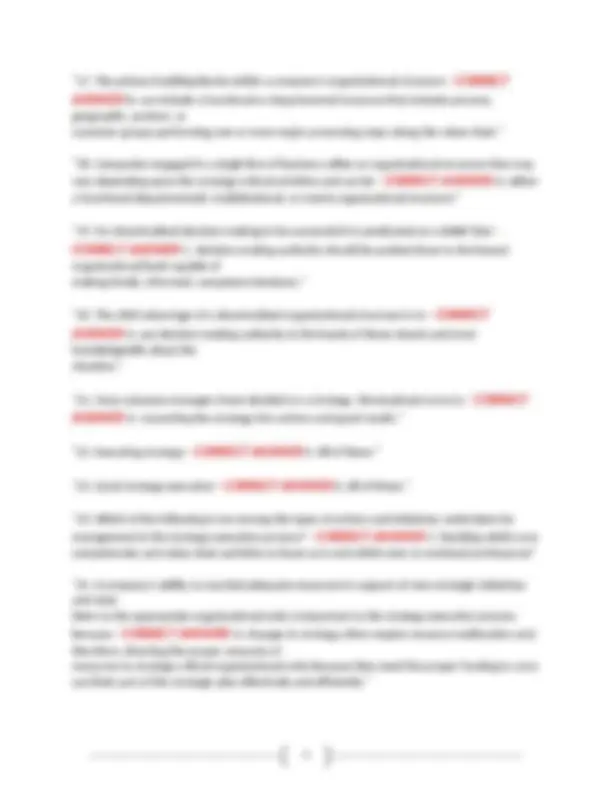
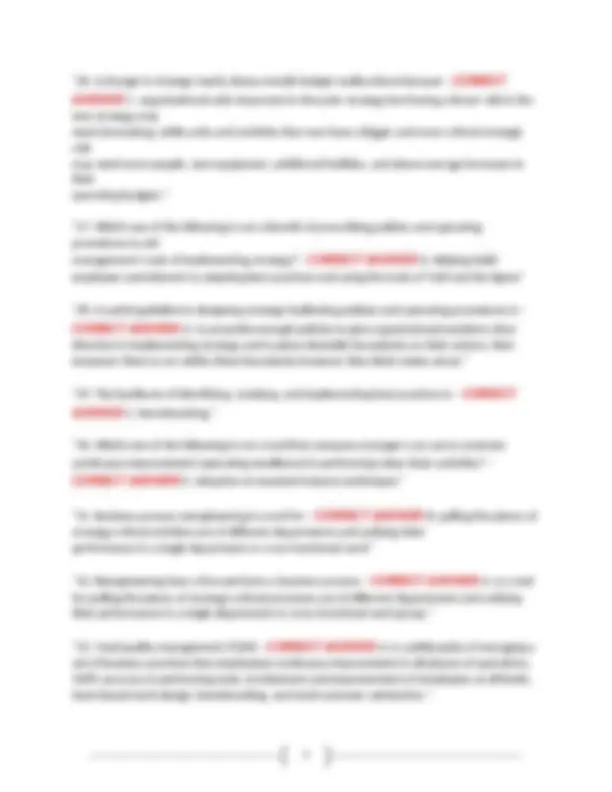
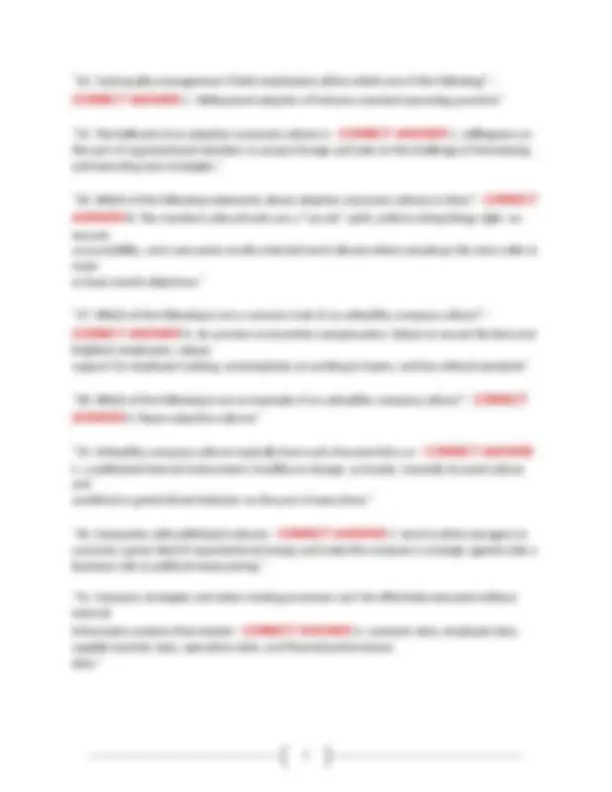
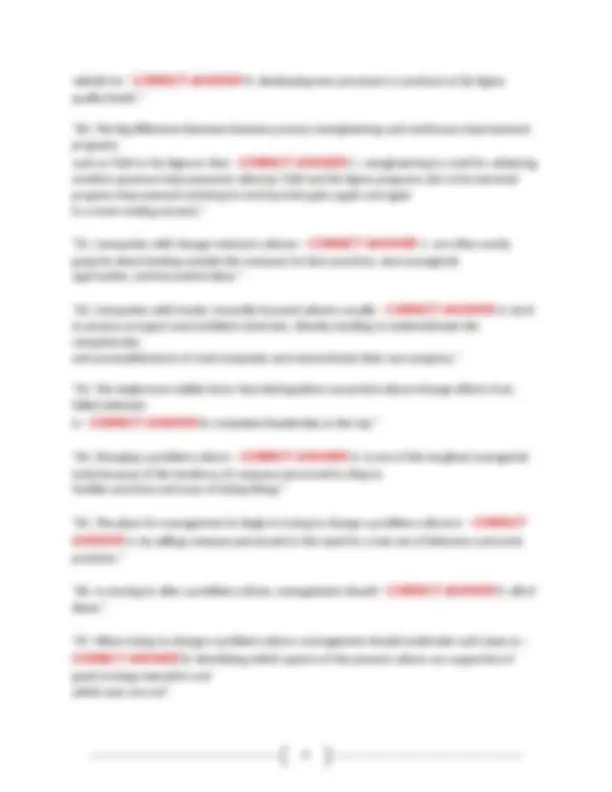
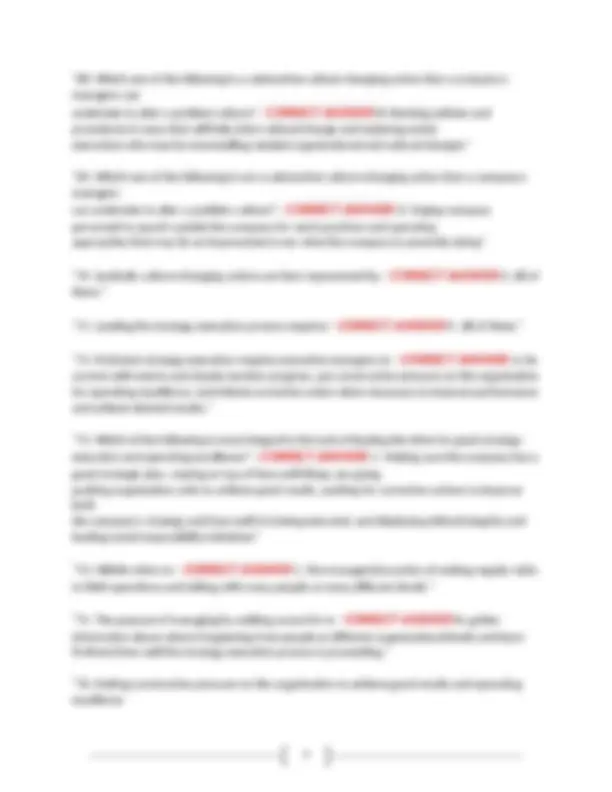
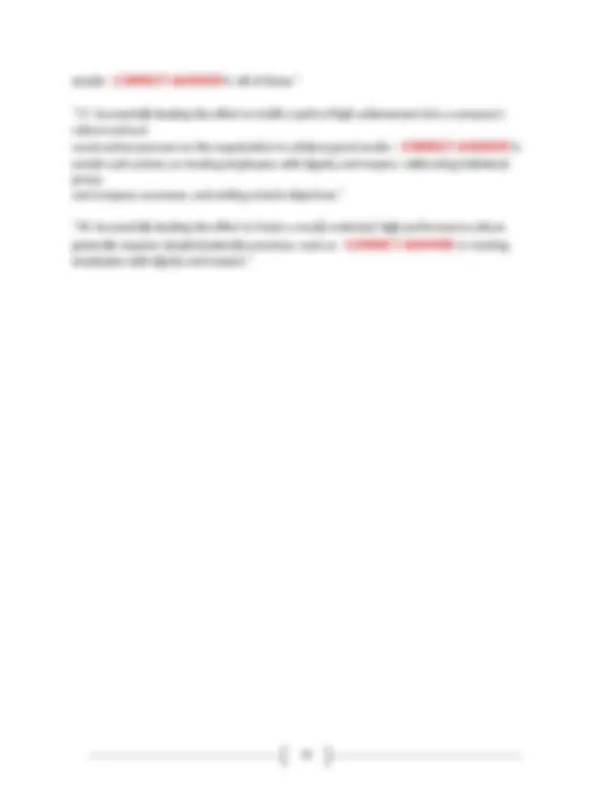


Study with the several resources on Docsity

Earn points by helping other students or get them with a premium plan


Prepare for your exams
Study with the several resources on Docsity

Earn points to download
Earn points by helping other students or get them with a premium plan
Community
Ask the community for help and clear up your study doubts
Discover the best universities in your country according to Docsity users
Free resources
Download our free guides on studying techniques, anxiety management strategies, and thesis advice from Docsity tutors
CHAPTER 10 BUSINESS STRATEGY QUESTIONS WITH CORRECT ANSWERS
Typology: Exams
1 / 10

This page cannot be seen from the preview
Don't miss anything!







"1. The organizing challenge of a decentralized structure that stresses employee empowerment
of empowered employees so that the business is not put at risk while trying to capture the benefits of empowerment."
people can outperform a company that relies on command and control"
A. making the organization sluggish in responding to changing conditions." "5. The principal managerial actions and initiatives undertaken in the strategy execution process include
facilitate rather than impede effective strategy execution" "6. The principal managerial actions and initiatives undertaken in the strategy execution process include
staffing the organization, building core competencies and competitive capabilities, and structuring the organization and work effort."
A. staffing the organization, building core competencies and competitive capabilities, and structuring the organization and work effort."
key managerial slots with people who are good at figuring out what needs to be done and skilled in "making it happen" and delivering good results."
assemble a critical mass of talented managers who can function as agents of change and further the cause of first-rate strategy execution."
because the quality of an organization's people is always an essential ingredient of successful strategy execution—knowledgeable, engaged employees are a company's best source of creative ideas for the nuts-and-bolts operating improvements that lead to operating excellence." "12. Which one of the following statements about recruiting and retaining capable employees is
ingredient of successful strategy execution—knowledgeable, engaged employees are a company's best source of creative ideas for the nuts-and-bolts operating improvements that lead to operating excellence." "13. Which of the following is generally not among the practices that companies use to staff
lowest-performing employees each year" "14. Which one of the following is not a means of building and strengthening competitively
centralized decision making so as to give senior executives more authority and control in driving cultural change." "15. If management is to match a company's organization structure to its strategy in an effective way, then
building blocks on the organization chart." "16. The rationale for making strategy-critical value chain activities the primary building blocks
activities crucial to strategic success are to have the resources, decision-making influence, and organizational impact they need, they have to be centerpieces in the organizational scheme."
new strategy may need downsizing, while units and activities that now have a bigger and more critical strategic role may need more people, new equipment, additional facilities, and above-average increases in their operating budgets." "27. Which one of the following is not a benefit of prescribing policies and operating procedures to aid
employee commitment to adopting best practices and using the tools of TQM and Six Sigma"
direction in implementing strategy and to place desirable boundaries on their actions, then empower them to act within these boundaries however they think makes sense."
"30. Which one of the following is not a tool that company managers can use to promote
strategy-critical activities out of different departments and unifying their performance in a single department or cross-functional work"
for pulling the pieces of strategy-critical processes out of different departments and unifying their performance in a single department or cross-functional work group."
set of business practices that emphasizes continuous improvement in all phases of operations, 100% accuracy in performing tasks, involvement and empowerment of employees at all levels, team-based work design, benchmarking, and total customer satisfaction."
the part of organizational members to accept change and take on the challenge of introducing and executing new strategies."
excuses accountability, and a pervasive results-oriented work climate where people go the extra mile to meet or beat stretch objectives."
brightest employees, subpar support for employee training, overemphasis on working in teams, and low ethical standards"
C. a politicized internal environment, hostility to change, an insular, inwardly focused culture, and unethical or greed-driven behavior on the part of executives."
consume a great deal of organizational energy and make the company's strategic agenda take a backseat role to political maneuvering." "41. Company strategies and value creating processes can't be effectively executed without internal
supplier/partner data, operations data, and financial performance data."
All of these."
a "can-do" spirit, pride in doing things right, no-excuses accountability, and a pervasive results oriented work climate where people go the extra mile to meet or beat stretch objectives."
standards, a strong preference for high-risk strategies, and a slow and methodical approach to responding to changes in the marketplace."
success when extended to employee efforts in all departments—human resources, R&D, accounting and records, information systems, and so forth."
based system aimed at producing not more than 3.4 defects per million iterations for any business process"
create data that explains variability"
specification and needing incremental improvement; the DMAIC process is a particularly good vehicle for improving performance when there are wide variations in how well an activity is performed" "59. Six Sigma's DMADV process of define, measure, analyze, design and verify is a particularly good
quality levels." "60. The big difference between business process reengineering and continuous improvement programs
onetime quantum improvements whereas TQM and Six Sigma programs aim at incremental progress improvement (striving for inch-by-inch gains again and again in a never-ending stream)."
gung-ho about looking outside the company for best practices, new managerial approaches, and innovative ideas."
to possess arrogant overconfident mind-sets, thereby tending to underestimate the competencies and accomplishments of rival companies and overestimate their own progress." "63. The single most visible factor that distinguishes successful culture-change efforts from failed attempts
tasks because of the tendency of company personnel to cling to familiar practices and ways of doing things."
practices."
these."
good strategy execution and which ones are not"
"77. Successfully leading the effort to instill a spirit of high achievement into a company's culture and put
entails such actions as treating employees with dignity and respect, celebrating individual, group, and company successes, and setting stretch objectives." "78. Successfully leading the effort to foster a results-oriented, high-performance culture
employees with dignity and respect."